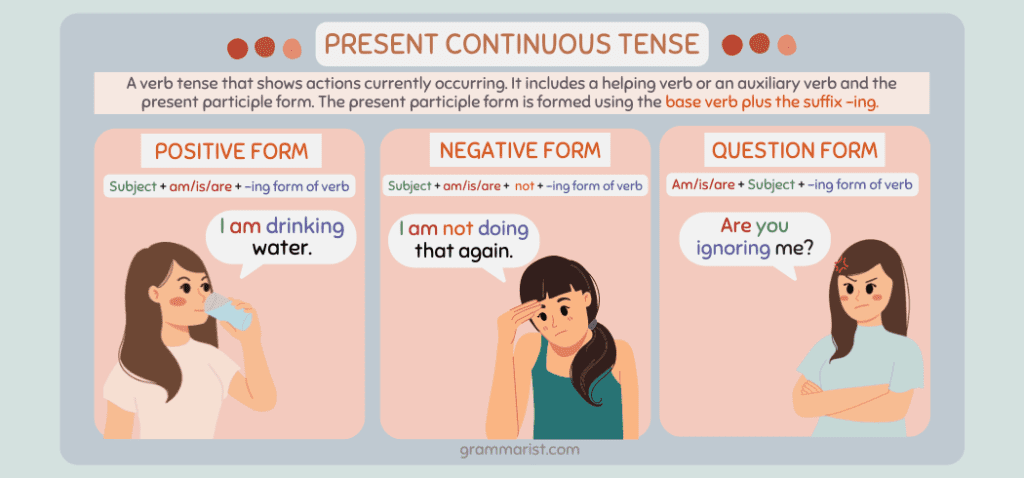The common present continuous tense is also known and used by some as the present progressive tense. This verb tense expresses actions currently happening. I would use this if I were writing something in first person POV with a present tense aka events are currently unfolding.
Discover the uses, rules, and examples of the present continuous tense as I break everything down. Once you learn how to use the present continuous tense, you’ll be able to add liveliness and action to your writing. I promise!
What is the Present Continuous or Present Progressive Tense?

The present continuous tense is a verb tense that shows actions currently occurring. This tense also indicates when the event is temporary.
Like other continuous tenses, present continuous uses the present participle form of a verb. Present continuous verbs include a helping verb or an auxiliary verb and the present participle form.
The present participle form is formed using the base verb plus the suffix -ing. For instance, fix becomes fixing.
Books like All the Light We Cannot See by Anthony Doerr are written in present continuous tense if you want to check them out and get a good feel of it.
The Present Continuous Formula
You can construct a present continuous verb in several ways, depending on the sentence type. Here’s what I would do.
For affirmative sentences, the present continuous form is:
- Subject + am/is/are + -ing form of the verb.
To make the sentence negative, follow this construction:
- Subject + is/am/are + NOT + -ing form of the verb.
If you wish to write question sentences, here is the formula for the question form.
- Am/is/are + subject + -ing form of the verb.
Remember to observe subject-verb agreement when constructing these sentences. Use is for singular subjects and are for plural subjects. The auxiliary verb am is for the subject I.
How to Use the Present Continuous Tense

Let’s discuss the different uses of the present continuous tense. I’ll throw in some examples, too.
When Something is Happening at the Present Time
Use the present continuous tense with normal verbs to express something currently happening. This tense also expresses an action that is not happening right now. Here are some sentences with present continuous verbs.
- Donna is traveling to New York.
- I am reading Ottessa Moshfegh’s novel.
- My sister’s personal trainer is seeing my friend.
Notice how all topics in the examples show ongoing action.
When Something is Happening at the Time of Speaking
Use this grammatical tense for actions currently happening while you are speaking. It can be an action you’re doing or a specific event occurring. For example:
- My aunt is baking cookies now.
- I am eating dinner at the moment.
Regular Unplanned Events
You should use the present continuous with words like always, continually, and constantly to describe regular events that do not entail a firm plan. These events are also typically unwanted or indicative of irritation. For example:
- My husband is always going out late at night.
- I am constantly breaking things in the house.
When Describing a Future Plan
The present continuous form is essential when we want to share what we have planned at a specific time in the future. Remember to use time expressions in these sentences to show a specific period of time for future plans. For example:
- I’m writing him a letter tonight.
- Sasha is starting driving lessons this summer break.
When Indicating a Temporary Event
Use the present continuous tense when a situation is temporary. Take a look at the sentences below.
- I usually read romance fiction, but I’m reading non-fiction tonight.
- Los Angeles looks sunny, but I’m staying in Chicago at the moment.
When Asking Certain Types of Questions
Present continuous questions express questions about actions currently happening. For example:
- Are we buying that house?
Don’t Use It With Stative Verb Categories
Stative verbs are ones that show a state of being. They do not show qualities of change, and they always stay in simple present form. For example:
- Incorrect: I am preferring the brown leather jacket over the knitted cardigan.
Correct: I prefer the brown leather jacket over the knitted cardigan.
Non-continuous verbs/mixed verbs cannot be used in continuous tenses. Meanwhile, dynamic verbs describe actions that begin and end. Some examples of dynamic verbs are run, drive, and eat. These verbs work with the present continuous tense.
You can also use perception verbs with present continuous tense. These are see, hear, feel, taste, and smell.
Present Continuous Examples in Sentences
Below are some examples of present continuous tense sentences.
- The professor is sending the lessons by email this November.
- I am working on a new project.
- Are you asking comprehension questions to your students?
- Lorna’s daughter is studying to be a neurologist.
- The committee is planning to restructure the church.
- I am reading My Year of Rest and Relaxation.
- Are you listening to me?
- You’re constantly twitching when sleeping.
- They are running later.
Final Word on Present Continuous Tense
Now you know the definition, rules, and formula for using the present continuous tense. This verb tense is used for actions that are occurring now, temporary events, planned and unplanned situations, and future plans.
Remember what I said about that the present continuous tense always useing the helping verbs is/are/am and the present participle form of the verb.